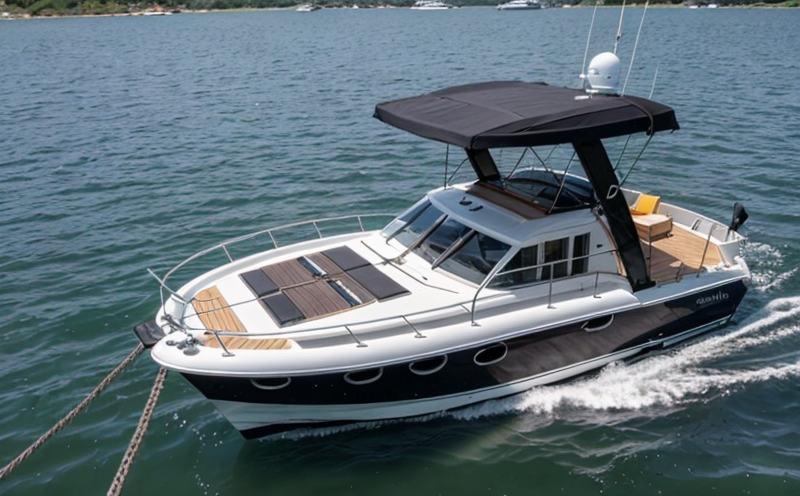ISO 2307 Rope Breaking Force Testing for Marine Use
The International Organization for Standardization (ISO) defines specific standards for ensuring the safety and reliability of equipment used in marine environments. One such standard is ISO 2307, which specifies the breaking force testing procedures for ropes intended for use on ships and offshore structures.
These ropes are critical components that must withstand harsh environmental conditions, including saltwater exposure, UV radiation, and high loads. The purpose of this test is to ensure that the rope can safely handle the forces it will encounter during its operational life without failing prematurely. This testing procedure ensures that the equipment meets stringent safety requirements set by international maritime regulations.
The standard outlines detailed procedures for conducting breaking force tests on ropes used in marine applications, including the preparation of specimens and the setup of test apparatus. The test involves subjecting a rope sample to increasing tension until it breaks. The maximum load at which failure occurs is recorded as the breaking strength. This value is crucial for determining the safe working load (SWL) that can be assigned to the rope.
For accurate testing, ropes are typically tested in their natural state, meaning they have not been pre-stretched or treated with lubricants. The test apparatus should replicate real-world conditions as closely as possible. Factors such as temperature and humidity may also influence the results and must be controlled during testing to ensure consistent and reliable data.
The breaking force test is a critical step in validating the quality of marine ropes. It helps manufacturers, shipyards, and offshore operations to select suitable materials that can withstand the rigors of maritime use. By adhering to ISO 2307 standards, industries can enhance safety and compliance with international regulations.
The test procedure involves several key steps:
- Preparing rope specimens in their natural state
- Securing the specimen into a testing machine
- Applying controlled tension until failure occurs
- Recording the maximum load at which the rope breaks
The results of this test are used to determine the SWL, which is essential for ensuring that ropes do not fail under expected loads. This information is vital for the safe operation of ships and offshore structures.
ISO 2307 also covers other aspects such as the influence of environmental factors on rope performance, including saltwater exposure and UV radiation. These elements can degrade rope materials over time, reducing their breaking strength and durability. Therefore, testing ropes in these conditions helps to ensure that they will perform reliably under real-world circumstances.
By complying with ISO 2307, manufacturers, shipyards, and offshore facilities can demonstrate their commitment to safety and quality. This standard provides a robust framework for evaluating the performance of marine ropes, ensuring that they meet or exceed international standards for maritime use.
Customer Impact and Satisfaction
The results of ISO 2307 testing have a significant impact on customer satisfaction within the marine and shipbuilding sectors. By ensuring that ropes meet or exceed safety requirements, manufacturers can build trust with their clients and demonstrate their commitment to quality.
- Enhanced Safety: Testing ensures that ropes do not fail under expected loads, reducing the risk of accidents at sea.
- Compliance Assurance: By adhering to ISO 2307 standards, manufacturers can comply with international maritime regulations and gain credibility in the market.
- Increased Reliability: Consistent test results lead to more reliable equipment, which is crucial for maintaining operational efficiency and safety.
Clients who rely on marine ropes for critical operations benefit from these testing procedures. They can trust that their suppliers are using the latest standards and technologies to ensure product quality and performance.
Environmental and Sustainability Contributions
ISO 2307 rope breaking force testing also contributes positively to environmental sustainability by promoting the use of durable, high-quality ropes. This ensures that ropes last longer in service, reducing waste and the need for frequent replacements.
- Reduced Waste: By ensuring that ropes are robust enough to withstand harsh conditions, the frequency of replacement is minimized, leading to less waste.
- Eco-friendly Manufacturing: The use of high-quality materials and standardized testing processes supports more sustainable manufacturing practices.
In addition to reducing environmental impact, ISO 2307 testing also helps to promote responsible resource management. By ensuring that ropes are designed with longevity in mind, industries can contribute to a more sustainable future.
Use Cases and Application Examples
The application of ISO 2307 rope breaking force testing is widespread across the marine industry, particularly for critical components such as mooring lines, anchor chains, and deck equipment. These ropes are exposed to extreme conditions, including heavy loads, saltwater, and UV radiation.
For example, in offshore oil and gas operations, the use of high-quality ropes ensures that platforms remain stable under harsh weather conditions. In shipbuilding, these ropes play a crucial role in ensuring safe mooring and anchoring procedures during loading and unloading operations.
The test results are also valuable for quality assurance teams within manufacturers. By using ISO 2307 as a benchmark, companies can ensure that their products meet or exceed industry standards, enhancing their reputation and market position.





